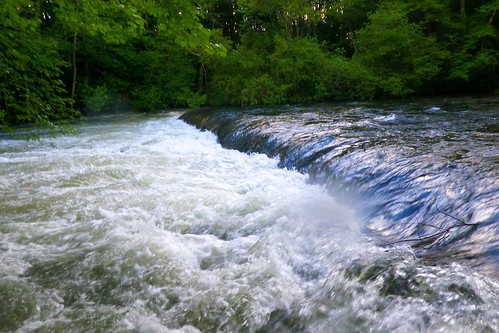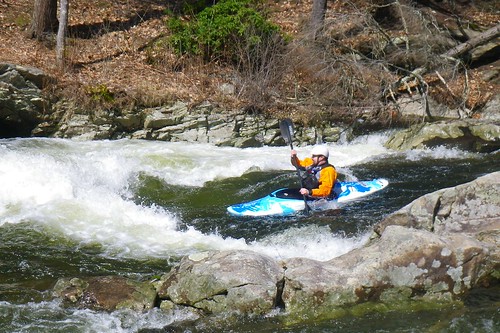I’d love to see a picture of the spot. As always, my approach to answering such a question is a little more vague, because I tend to imagine all sorts of subtleties that a person might want or need to react to which will vary by situation. I’m not much of one for cut-and-dried solutions, but have more of a blended-actions way of thinking.
For what you describe, I am picturing a simple curling wave, which is typical where a zone of fast water abruptly encounters slower water. The fact that you say this tends to throw you off your heading when you hit it makes me think it is diagonal, or that parts of it are diagonal, but that’s my guess. For what you described, and remembering a bit about your skill level and types of paddling, I didn’t envision a “keeper” at all, but any further description that you could provide helps.
For what I envision, slowing your approach will sometimes help a lot, as far as not plunging deeply into a wave, and also lessening the suddenness of how your boat might get knocked off its heading. Oftentimes, simply slowing to the speed of the current is enough to make a huge difference, but actually progressing backward against the current to slow your approach even more can be handy for a wave that’s especially big, but still presents no risk of “keeping” you. It doesn’t sound like this wave is big enough to warrant that, but it’s an option. Gung-Ho whitewater boaters virtually never think in this way, but if my goal is get through a tall, steep wave with a dry boat instead of with water sloshing around inside, reversing my power output enough so I hit the wave even slower than the speed of the current is often what I’ll do.
To me, a wave that suddenly shoves the bow of your boat to one side as you hit it can be very tricky, and Bill Mason used to say that this was one of the trickiest situations to encounter in a canoe. If the capsize risk is simply due to that sudden sideways movement, learn to anticipate what will happen, and learn to brace. Let’s say that the bow of the boat is going to get knocked sharply to the left when you hit the wave, resulting in a natural rolling/tipping action to the right (picture someone pulling a rug out from under you. Which way do you fall when your feet suddenly move with the rug to the left? You fall to the right, and the same thing happens to you if the hull of your boat gets suddenly pushed to the left). Be ready for that by leaning way off to the left, supporting yourself on a low brace, so that when the boat gets suddenly pushed in that direction, your own weight is more in-line with the shove provided by the wave and your body simply goes sideways along with the boat instead of lagging behind, so there’s no tipping/rolling motion. In actual fact, you can sometimes get away with leaning and bracing in the “wrong direction” if you are holding a good brace with your paddle, because the ultimate affect is to widen your zone of support so you are less prone to falling over, but “presenting the bottom of the boat to the force that pushes you” (leaning to the left in this particular example) is best.
If the capsize risk is simply the steepness of a diagonal wave and how the boat tips when it is somewhat parallel to the wave face, applying a “big wide brace” on the side you will tip toward is good, and what’s nice about this is that it’s so similar to the precaution described above (being tipped by your own momentum) that you can be ready for either of those two problems. This is related to what someone above said about how you should not coast through with your paddle in the air. A paddle in the water does far more good. I’ll often brace to widen my zone of support even if I’m not sure whether or not there’s a tipping risk hiding in the turbulence somewhere. With my paddle in the water, at least I’m ready, and if already bracing, more stable.
Finally, sometimes when your bow gets knocked to one side as you enter a diagonal wave, simply reaching well behind you to apply a strong pry or draw to get the stern side-slipping in the same direction does wonders for keeping you in control. If the whole boat suddenly moves sideways instead of that action beginning at the bow, and when it’s partly due to your own paddling input instead of the river having its way with you, it’s hard to envision all the ways this helps, but you WILL be more in control, and naturally it will have the benefit of keeping your boat from presenting a partly-broadside aspect to whatever rocks might be waiting for you immediately below the wave.
Otherwise, try to pick a point on the wave that is less risky, like one end of the wave, or where two diagonal portions of the wave intersect (if there’s not a rock there). Again, I might be describing stuff that doesn’t apply, but these situations are pretty common, even on drops that are mostly innocuous.

